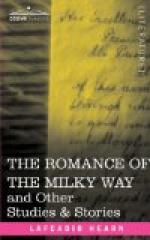Waga tam[’e] to,
Tanabata-tsum[’e] no,
Sono yado ni,
Oreru shirotai
Nu[:i]t ken kamo?
[The white cloth which
Tanabata has woven for my sake, in
that dwelling of hers, is
now, I think, being made into a robe
for me.]
Shirakumo no
I-ho [’e] kakurit[’e]
T[=o]-k[’e]domo,
Yo[:i]-sarazu min
Imo ga atari wa.
[Though she be far-away,
and hidden from me by five hundred
layers of white cloud, still
shall I turn my gaze each night
toward the dwelling-place
of my younger sister (wife).]
Aki sar[’e]ba
Kawagiri tat[’e]ru
Amanogawa,
Kawa ni muki-it[’e]
Kru[19] yo zo [=o]ki!
[Footnote 19: For kofuru.]
[When autumn comes, and
the river-mists spread over the
Heavenly Stream, I turn toward
the river, (and long); and the
nights of my longing are many!]
Hito-tos[’e] ni
Nanuka no yo nomi
A[:u]-hito no—
Ko[:i] mo tsuki-n[’e]ba
Sayo zo ak[’e] ni keru!
[But once in the whole year, and only upon the seventh night (of the seventh month), to meet the beloved person—and lo! The day has dawned before our mutual love could express itself![20]]
[Footnote 20: Or “satisfy itself.” A literal rendering is difficult.]
Toshi no ko[:i]
Koyo[:i] tsukush[’i]t[’e],
Asu yori wa,
Tsun[’e] no gotoku ya
Waga ko[:i] oran.
[The love-longing of one
whole year having ended to-night,
every day from to-morrow I
must again pine for him as
before!]
Hikoboshi to
Tanabata-tsum[’e] to
Koyo[:i] a[:u];—
Ama-no-Kawa to ni
Nami tatsu-na yum[’e]!
[Hikoboshi and Tanabata-tsum[’e]
are to meet each other
to-night;—ye waves
of the River of Heaven, take heed that ye
do not rise!]
Aki-kaz[’e] no
Fuki tadayowasu
Shirakumo wa,
Tanabata-tsum[’e] no
Amatsu hir[’e] kamo?
[Oh! that white cloud driven
by the autumn-wind—can it be
the heavenly hir[’e][21]
of Tana-bata-tsum[’e]?]
[Footnote 21: At different times, in the history of Japanese female costume, different articles of dress were called by this name. In the present instance, the hir[’e] referred to was probably a white scarf, worn about the neck and carried over the shoulders to the breast, where its ends were either allowed to hang loose, or were tied into an ornamental knot. The hir[’e] was often used to make signals with, much as handkerchiefs are waved to-day for the same purpose;—and the question uttered in the poem seems to signify: “Can that be Tanabata waving her scarf—to call me?” In very early times, the ordinary costumes worn were white.]
Shiba-shiba mo
Ai minu kimi wo,
Amanogawa
Funa-d[’e] haya s[’e]yo
Yo no fuk[’e]nu ma ni.




